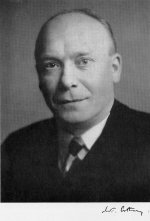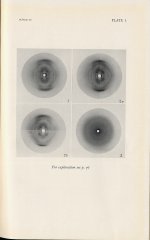|
Pauling had played around in a desultory way with nucleic acid structures as early
as 1933 without much in the way of results. After solving the alpha helix, in the
summer of 1951 he turned briefly to DNA again, when he learned that a fellow named
Maurice Wilkins at King's College in London had some good DNA x-ray photos. But when
Pauling asked Wilkins (and then Wilkins' superior) if he might see the DNA work, he
was rebuffed - Wilkins wanted to publish the results himself. That left Pauling with
only William Astbury's blurry x-ray patterns from the 1930s and one new photograph published in 1947.
From this inadequate data, Pauling could get some rough ideas of dimensions and the
size of repeating units, but they were too muddy to get much more.
|
|
Click images to enlarge

Portrait of William T. Astbury. 1950s.

"X-Ray Studies of Nucleic Acids." 1947.
"I hope you'll write to Prof. J. T. Randall, Kings College, Strand, London. His coworker,
Dr. M. Wilkins, told me he had some good fibre pictures of nucleic acid."
|

